Unveiling the Beauty of Hukou Waterfall: Travel Tips and Insights
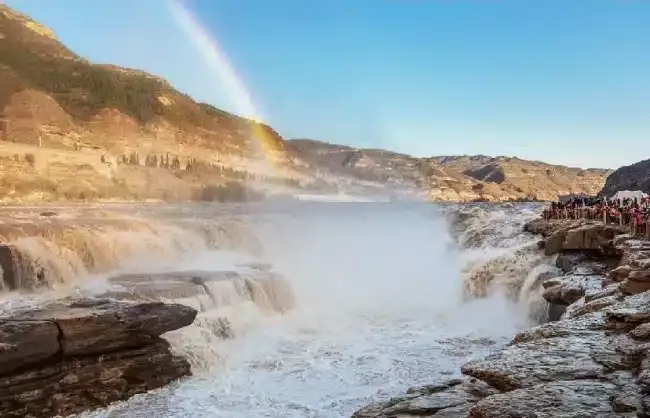
An Essential Guide to Visiting Hukou Waterfall
In This Guide
- An Essential Guide to Visiting Hukou Waterfall
- The Rich History and Legends of Hukou Waterfall
- Main Highlights: What You Absolutely Can’t Miss
- Planning Your Visit: A Practical Guide
- Tickets: Prices, Booking, and Tips
- How to Get There: A Complete Transportation Guide
- Local Cuisine and Accommodation Nearby
- Frequently Asked Questions
- Final Thoughts on Your Trip
Discovering the Majesty of Hukou Waterfall
Nestled at the confluence of Shanxi and Shaanxi provinces, Hukou Waterfall (壶口瀑布) stands as a breathtaking testament to nature’s raw power and beauty. As the second-largest waterfall in China and the largest on the iconic Yellow River, Hukou is often referred to as “the only yellow waterfall in the world,” a nod to the silt-laden waters that cascade dramatically over its rocky precipice. Spanning an impressive 300 meters in width, the river narrows to just 20 meters before plunging 20 meters down into a gorge, creating a thunderous roar that resonates across the landscape.
This spectacular natural wonder is not just a visual feast; it is steeped in history and culture, echoing the stories of the ancient civilizations that flourished along the Yellow River. For international travelers, Hukou Waterfall offers a unique opportunity to connect with both the stunning scenery and the rich heritage of this pivotal region in Chinese history.
What to Expect: Visitors can explore the area from multiple viewpoints, each offering a different perspective of the waterfall’s grandeur. The experience is enhanced by the vibrant local culture, with opportunities to learn about the Yellow River’s significance in Chinese mythology and its role in shaping the surrounding communities.
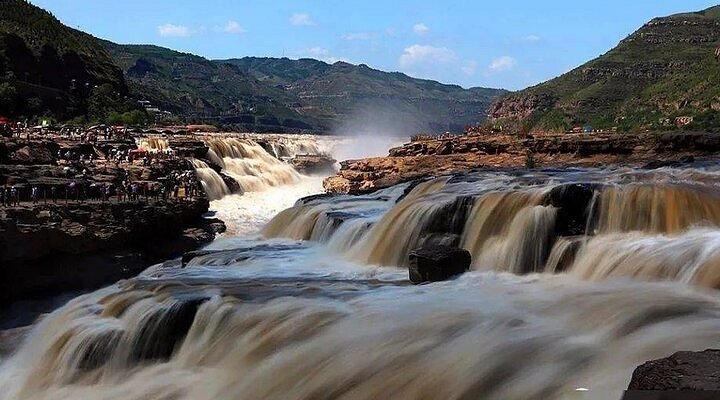
Hukou Waterfall.
Planning Your Visit: While Hukou Waterfall is accessible year-round, the best time to visit is during the late spring and early summer when the water flow is particularly vigorous. However, travelers should keep in mind that weather conditions can affect accessibility, especially during the monsoon season.
A trip to Hukou is more than just a visit to a waterfall—it’s an immersion into the heart of China’s natural beauty and historical narrative. Prepare to be captivated by the sights and sounds of this majestic landmark, a true gem that promises to leave a lasting impression.
The Rich History and Legends of Hukou Waterfall
A Journey Through Time and Myth at Hukou Waterfall
Nestled at the confluence of Shanxi and Shaanxi provinces, Hukou Waterfall is not only a natural spectacle but also a site steeped in rich history and captivating legends. As the second largest waterfall in China and the largest on the mighty Yellow River, its unique features and cultural significance make it a must-visit destination for those interested in the intertwining of nature and folklore.
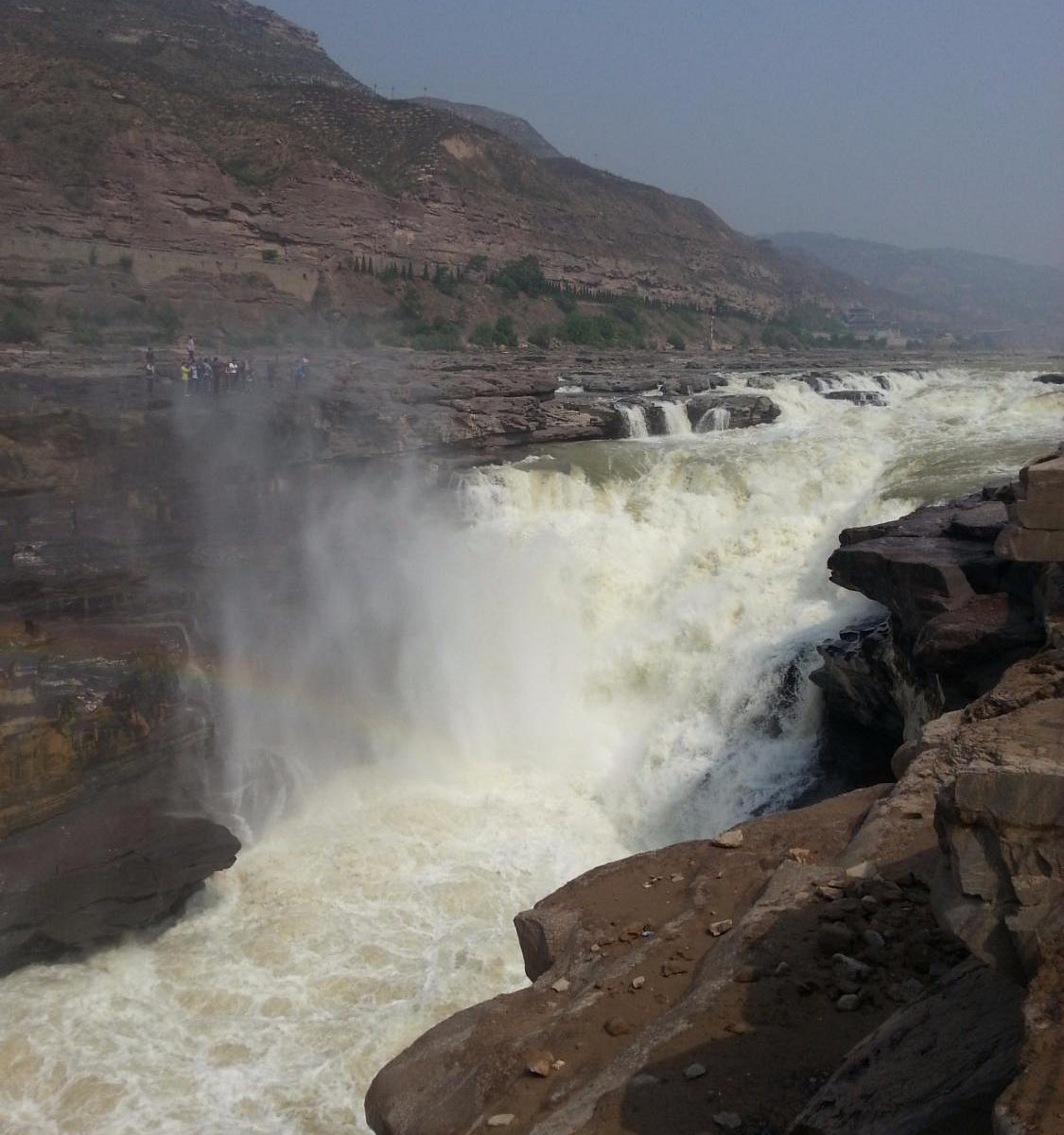
Hukou Waterfall.
Historical Significance
Hukou Waterfall has long played a crucial role in the history of the Yellow River, often referred to as the “Mother River” of China. This waterway has been a lifeline for countless generations, providing sustenance, transport, and a means of irrigation to the surrounding areas. The river’s turbulent waters have carved the landscape over millennia, giving rise to the breathtaking waterfall that we see today.
The waterfall’s name, “Hukou,” translates to “Kettle Mouth,” a fitting description of how the Yellow River narrows dramatically before plunging into the gorge. This geographical feature has not only shaped the natural environment but has also been a vital point of reference in the cultural and social development of the local communities. Historically, the region surrounding Hukou has served as a strategic location for trade and communication between northern and southern China.
Legends and Folklore
Like many natural wonders, Hukou Waterfall is surrounded by a tapestry of legends that reflect the beliefs and values of the local people. One of the most famous tales is that of the “Yellow River Goddess.” According to folklore, a beautiful goddess once resided in the depths of the river. She is said to have fallen in love with a mortal man, bringing him to the river’s edge. However, their love was thwarted by fate, and in her despair, she transformed into the waterfall, forever weeping for her lost love.

Hukou Waterfall.
This legend speaks to the powerful connection between nature and human emotion, a theme prevalent in many Chinese stories. Visitors often reflect on this poignant narrative as they witness the thundering waters, which seem to echo the goddess’s eternal sorrow.
Another legend tells of a great dragon that once roamed the land, bringing chaos and destruction. The emperor, seeking to protect his people, called upon a brave warrior to tame the beast. After a fierce battle, the warrior succeeded in subduing the dragon, which then fell into the Yellow River. The dragon’s body created the waterfall, symbolizing the triumph of good over evil and the establishment of harmony in the natural world.
Cultural Significance
Hukou Waterfall is not only a natural marvel but also a cultural emblem. It has inspired countless poets, artists, and philosophers throughout Chinese history. The waterfall’s unique yellow hue, caused by the silt-laden waters of the Yellow River, has become a symbol of the resilience and strength of the Chinese people. The surrounding region is rich in cultural heritage, with ancient villages and historic sites that provide insight into the lives of those who have thrived in this area for centuries.
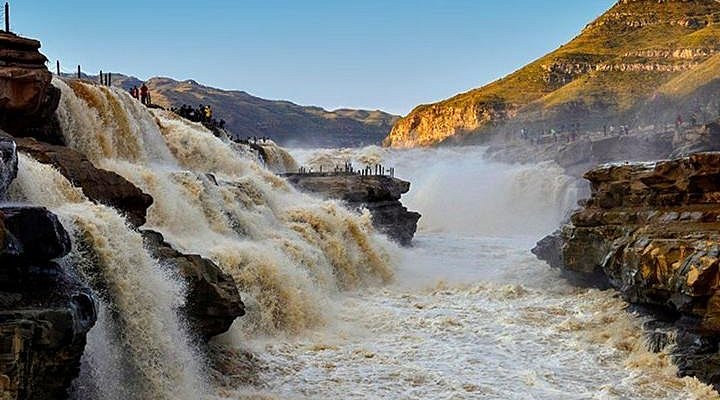
Hukou Waterfall.
Visitors to Hukou Waterfall can immerse themselves in this rich tapestry of history and legend, exploring local customs and traditions that have been passed down through generations. Whether it’s through guided tours or independent exploration, travelers are encouraged to engage with the local culture, experiencing firsthand the stories that breathe life into this magnificent natural wonder.
Conclusion
As you stand before the majestic Hukou Waterfall, take a moment to appreciate not only its physical beauty but also the profound history and legends that resonate within its cascading waters. From the tales of the Yellow River Goddess to the heroic warrior who tamed the dragon, Hukou is a place where nature and mythology intertwine, offering a unique glimpse into the heart of Chinese culture. This site is a reminder of the enduring power of storytelling, reflecting the spirit of a people who have revered and respected this land for millennia.
Main Highlights: What You Absolutely Can’t Miss
Discover the Majesty of Hukou Waterfall
Hukou Waterfall, known as the “Yellow Waterfall,” is a breathtaking natural wonder that commands respect and admiration. As the second largest waterfall in China and the largest on the iconic Yellow River, it offers visitors a unique perspective on the power of nature. Here are the key highlights you absolutely cannot miss during your visit.
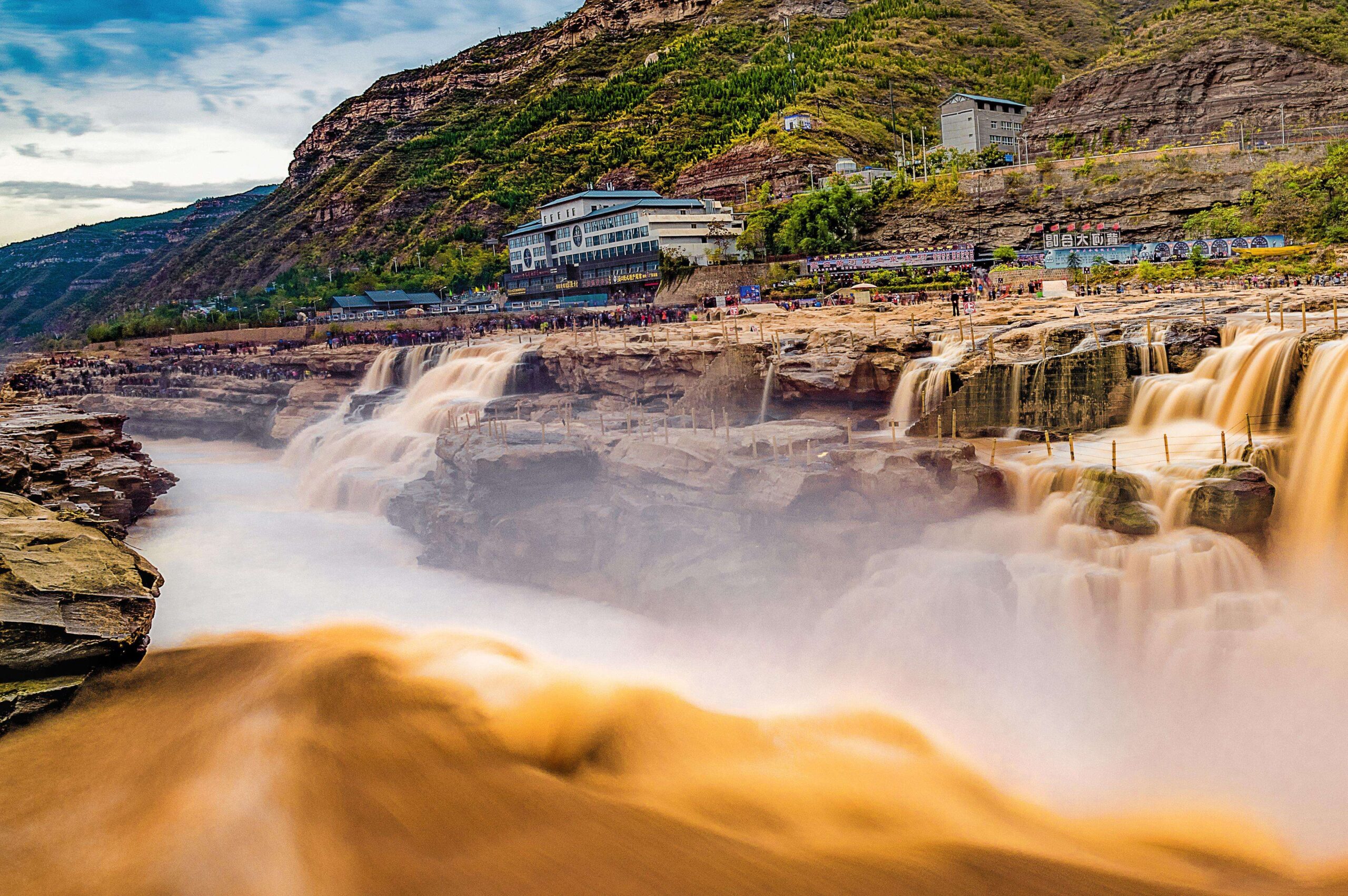
Hukou Waterfall.
1. The Spectacular Waterfall
- Dimensions: Spanning an impressive 300 meters in width, the waterfall plunges dramatically into a narrow gorge, creating a thunderous roar that can be heard from afar. The sheer force of the water, especially during the rainy season, is a sight that leaves visitors in awe.
- Unique Color: The distinctive yellow hue of the water is due to the silt and sediment carried by the Yellow River, giving it an unusual yet captivating appearance. This is often referred to as the “only yellow waterfall in the world,” making it a rare marvel.
2. Best Viewing Points
- Shaanxi vs. Shanxi: The waterfall can be viewed from both the Shaanxi and Shanxi sides. The Shaanxi side offers a magnificent view of the waterfall’s breadth, while the Shanxi side provides a closer look at the river’s plunge into the gorge. For the best photo opportunities, visit the Shaanxi side in the afternoon when the sunlight enhances the waterfall’s beauty.
- Accessibility: The area is equipped with convenient shuttle buses for easy access to the viewing platforms, ensuring a smooth experience for visitors.

Hukou Waterfall.
3. Surrounding Natural Beauty
- Scenic Trails: The surrounding landscape features several hiking trails, including the Jedi Trail, which allows visitors to explore the stunning natural beauty of the region. Don’t miss the chance to hike Yumao Peak for panoramic views of the Yellow River and the waterfall.
- Wildlife and Flora: The lush environment around the waterfall is home to diverse flora and fauna, making it an excellent spot for nature lovers and photographers.
4. Cultural Significance
- Historical Context: The Yellow River holds immense significance in Chinese culture, often referred to as the “Mother River.” Understanding the river’s history and its role in shaping Chinese civilization adds a rich layer to your visit. Consider hiring a knowledgeable guide to share insights into the area’s historical importance.
- Local Villages: Take the opportunity to explore nearby attractions, such as the quaint Dangjia Village, where you can experience traditional Chinese rural life and cuisine.
5. Practical Information
- Visiting Hours: Hukou Waterfall is open daily from 8:00 AM to 6:00 PM, providing ample time to explore the area.
- Entrance Fees: The entrance fee is RMB 100 for the head-on view and RMB 50 for the rear view, with shuttle bus services available at a minimal cost.
- Weather Considerations: Be mindful of the weather, as conditions can vary significantly. The best time to visit is during the dry season when the waterfall is at its most majestic.

Hukou Waterfall.
6. Photography Tips
- Camera Protection: The mist created by the waterfall can leave a fine layer of silt on your camera lenses. Protect your gear with appropriate coverings to ensure you capture the stunning views without damage.
- Timing Your Shots: Early morning and late afternoon provide the best lighting for photography, enhancing the colors and details of the waterfall and its surroundings.
Conclusion
A visit to Hukou Waterfall is not merely about witnessing a natural spectacle; it’s an immersion into the history and culture of China, set against the backdrop of one of its most important rivers. Whether you’re drawn by the natural beauty, the cultural significance, or simply the thrill of experiencing one of the world’s unique waterfalls, Hukou offers an unforgettable experience that will leave a lasting impression.
Planning Your Visit: A Practical Guide
Essential Tips for Visiting Hukou Waterfall
Nestled between the Shanxi and Shaanxi provinces, Hukou Waterfall is not only the second-largest waterfall in China but also a stunning natural wonder that embodies the raw power of the Yellow River. Before you embark on your journey to this unique site, here’s a practical guide to help you make the most of your visit.
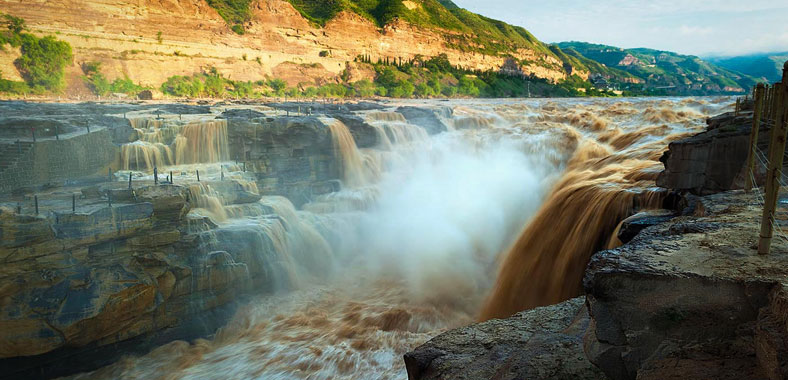
Hukou Waterfall.
Getting There
Location:
Hukou Waterfall is located in Ji County, approximately 3.5 to 4 hours from Xi’an, making it a feasible day trip.
Transportation Options:
– By Car: Renting a car or hiring a taxi from Xi’an is a convenient option, offering flexibility in your itinerary.
– Public Transport: Buses from Xi’an to Hukou Town are available, but schedules may vary, so check in advance to avoid delays.
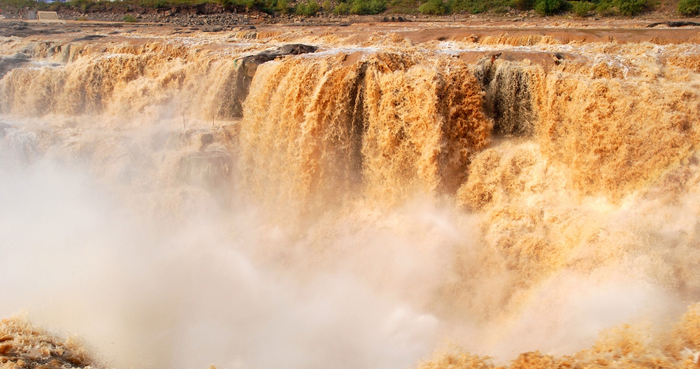
Hukou Waterfall.
Entrance Fees and Hours
- Entrance Fee:
- Front View: RMB 100
- Rear View: RMB 50
-
Shuttle Bus (to the waterfall area): RMB 10 each way
-
Operating Hours:
Daily from 8:00 AM to 6:00 PM. Arriving early can help you beat the crowds and capture the best views.
Best Time to Visit
The waterfall is most spectacular during the rainy season (July to September), when the Yellow River swells and the falls roar with thunderous energy. However, be mindful of the weather, as heavy rains can lead to road closures and slippery conditions. For the best photographic opportunities, aim for the afternoon on the Shaanxi side, where the sun illuminates the falls beautifully.
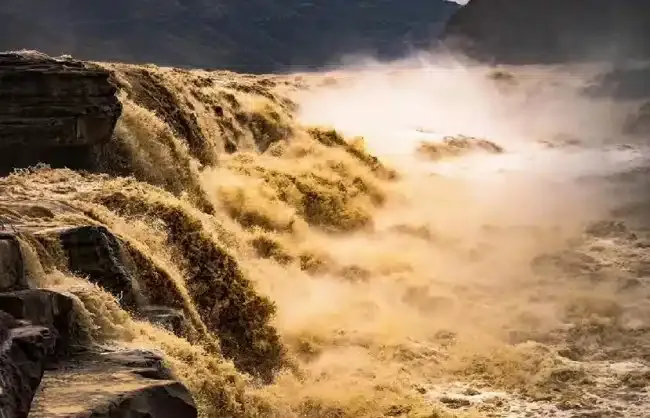
Hukou Waterfall.
Viewing Points
Sides of the Waterfall:
– Shaanxi Side: Offers a broad view of the waterfall’s length and is ideal for photography.
– Shanxi Side: Provides an up-close experience of the river plunging into the gorge.
Both viewpoints have their unique charm, so if time allows, consider experiencing both sides for a comprehensive view of this natural spectacle.
What to Bring
- Camera: Ensure your lens is protected from the fine mist created by the falling water. A waterproof cover is advisable.
- Comfortable Shoes: The terrain can be slippery, especially after rain, so wear sturdy footwear.
- Water and Snacks: While there are facilities around, it’s wise to carry your own refreshments, especially during busy seasons.
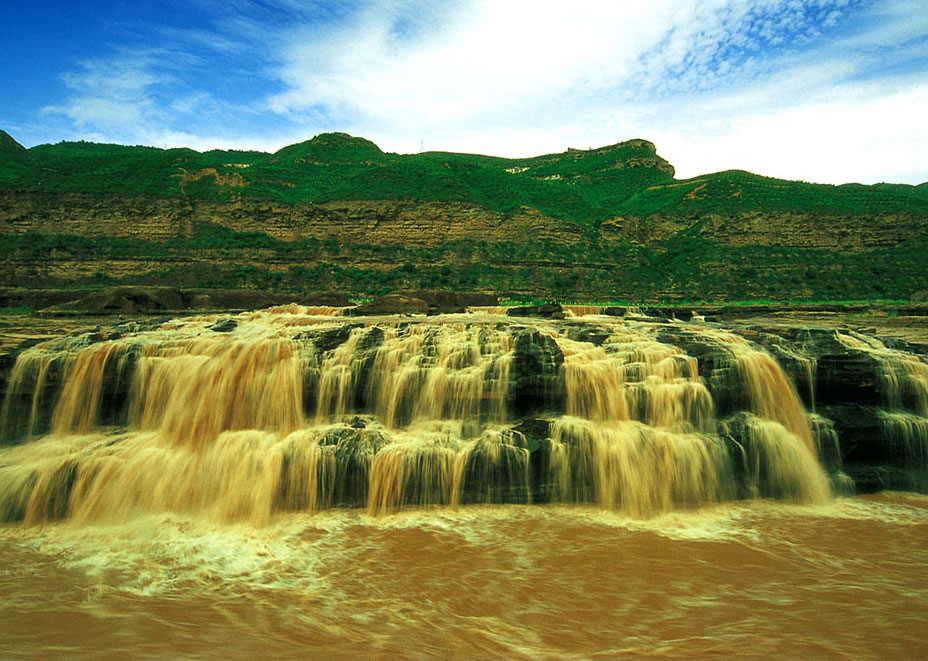
Hukou Waterfall.
Nearby Attractions
To enhance your visit, consider combining your trip to Hukou Waterfall with a visit to nearby attractions:
– Dangjia Village: A charming village in Hancheng that showcases traditional architecture and local culture.
– Yumao Peak: A scenic hiking spot offering breathtaking views of the surrounding landscapes.
Cultural Significance
The Hukou Waterfall is steeped in history and cultural lore. Known as the “only yellow waterfall in the world,” it’s a symbol of the Yellow River, which has played a pivotal role in Chinese civilization. Understanding this significance can enrich your experience as you witness the majestic flow of water that has inspired poets, artists, and travelers for centuries.

Hukou Waterfall.
Safety Precautions
While the view is mesmerizing, it’s important to maintain a safe distance from the riverbank. The powerful flow can be treacherous, and the noise of the water can be disorienting. Always stay within designated viewing areas and follow any posted safety guidelines.
Conclusion
Hukou Waterfall is a breathtaking natural wonder that provides a unique glimpse into the power of nature and the rich cultural tapestry of China. With proper planning and consideration, your visit can be a memorable highlight of your travels. Embrace the experience, and don’t forget to capture the beauty of this remarkable site!
Tickets: Prices, Booking, and Tips
Visiting the stunning Hukou Waterfall is a must for any traveler keen on experiencing the natural beauty and historical significance of China. To make the most of your visit, here’s a comprehensive guide to ticket prices, booking options, and some helpful tips.
Ticket Information
- Standard Admission:
- Front View: RMB 100 (approximately $14 USD)
-
Rear View: RMB 50 (approximately $7 USD)
-
Shuttle Bus:
- Cost: RMB 10 per person (one way)
- The shuttle bus operates between the ticket office and the waterfall viewing areas, making it convenient for visitors.
Booking Options
-
Advance Booking: While tickets can be purchased at the site, it is advisable to book in advance during peak tourist seasons to avoid long queues. Booking can typically be done through major travel websites or local tour operators.
-
Tour Packages: Consider joining a guided tour that combines the Hukou Waterfall with nearby attractions. Many tours offer comprehensive experiences, including transportation from major cities like Xi’an, making your trip more convenient. Prices for these tours generally range from $267 to $439, depending on the inclusions and duration.
Tips for Your Visit
-
Timing Your Visit: The waterfall is open daily from 8:00 AM to 6:00 PM. To capture the best photographs, aim to visit in the afternoon when the sun illuminates the falls from the Shannxi side, providing spectacular views.
-
Weather Considerations: Rainy weather can affect visibility and accessibility. If you are visiting during the monsoon season, be prepared for possible flooding and slippery conditions. Always check the weather forecast before your trip.
-
Photography Precautions: The mist from the waterfall can coat your camera lens with fine particles. Bring lens cloths to keep your equipment clean and ensure you can capture the waterfall’s breathtaking beauty.
-
Exploring Both Sides: The Hukou Waterfall can be viewed from both the Shanxi and Shannxi sides. Each side offers unique perspectives: the Shannxi side showcases the fall’s length, while the Shanxi side offers a dramatic view of the river plunging into the gorge. If time permits, visiting both sides is highly recommended.
-
Combine Your Itinerary: Given its location, it’s wise to pair your visit to Hukou Waterfall with other nearby attractions, such as the historic Dangjia Village. This will enrich your experience and make the most of your travel time.
Hukou Waterfall is not only a natural wonder but also a site steeped in the rich tapestry of Chinese history and culture. With this guide in hand, you’re well-prepared to embark on an unforgettable journey to one of China’s most magnificent waterfalls.
How to Get There: A Complete Transportation Guide
Navigating Your Way to Hukou Waterfall
Visiting Hukou Waterfall (壶口瀑布) is an unforgettable experience, where the might of the Yellow River plunges dramatically between the provinces of Shanxi and Shaanxi. To ensure you can fully enjoy this natural wonder, here’s a comprehensive transportation guide to help international travelers reach the waterfall with ease.
Arriving by Air
The nearest major airport to Hukou Waterfall is Xi’an Xianyang International Airport (XIY), located approximately 170 kilometers away. This airport serves both domestic and international flights, making it a convenient entry point into the region.
- From the Airport to Xi’an City Center:
- Taxi: A taxi ride will take about 30–40 minutes and cost around 100–150 RMB.
- Airport Shuttle: Buses are available and typically cost around 25 RMB per person, taking an hour to reach the city center.
Traveling from Xi’an to Hukou Waterfall
Once in Xi’an, your journey to Hukou Waterfall can be completed via various transport options:
- By Bus:
- Direct Bus: The most straightforward way is to take a direct bus from the Xi’an North Bus Station (西安北客运站) to Hukou Waterfall. Buses leave frequently, and the journey takes about 3.5 hours. Tickets cost approximately 60-75 RMB.
-
Tickets: It’s advisable to arrive early to secure your tickets, especially during peak seasons.
-
By Train:
- Train to Linfen: You can take a train from Xi’an to Linfen, which is about 100 kilometers from Hukou Waterfall. The train journey lasts roughly 2-3 hours.
-
Local Transport from Linfen: Once at Linfen, you can hire a taxi or take a local bus to reach Hukou Waterfall, which will take about 1.5 hours.
-
By Private Car:
- Renting a car or hiring a private driver is a flexible option for those who prefer a more personalized travel experience. The drive takes about 3 hours via the G108 national highway.
- Cost: Prices for car rentals vary significantly, so it’s best to check local rental services.
Tips for Getting Around
-
Shuttle Buses: Once you arrive at the Hukou Waterfall Scenic Area, be prepared to use the shuttle bus services that operate between the entrance and various viewing points of the waterfall. The fare is typically around 10 RMB each way.
-
Walking: The area around the waterfall offers pathways for visitors to explore. However, be cautious and wear proper footwear, especially after rainfall when the ground may be slippery.
Best Times to Visit
To experience the waterfall at its most magnificent, plan your visit during the rainy season, typically from July to September. However, keep in mind that heavy rains can lead to closed roads and paths.
Final Thoughts
Hukou Waterfall is not just a spectacular natural wonder but also a site steeped in cultural significance. While the journey may require some planning, the breathtaking views and the experience of standing before the “only yellow waterfall in the world” are well worth the effort. Whether you opt for public transport or a private vehicle, prepare yourself for an adventure that combines the beauty of nature with the rich history of the Yellow River.
Local Cuisine and Accommodation Nearby
Savoring the Flavors and Finding Comfort Near Hukou Waterfall
When visiting the majestic Hukou Waterfall, it’s not just the stunning views that captivate travelers; the local cuisine and accommodations also offer unique experiences that enrich your journey. Here, we delve into the culinary delights and lodging options available in the vicinity, ensuring your stay is as memorable as the waterfall itself.
Local Cuisine: A Taste of the Yellow River Region
The area around Hukou Waterfall is famed for its hearty and flavorful dishes, largely influenced by the agricultural bounty of the Yellow River basin. Here are some culinary highlights you shouldn’t miss:
-
Yellow River Carp: Freshly caught from the Yellow River, this fish is often grilled or braised, showcasing its tender meat and delicious flavor. Local restaurants serve it prepared in various styles, often accompanied by fragrant rice and seasonal vegetables.
-
Shanxi Noodles (刀削面): These hand-sliced noodles are a staple in the region. Served in a rich broth or stir-fried with vegetables and meat, they are a comforting dish that warms the soul after a day of exploration.
-
Shaanxi Roujiamo (肉夹馍): Often referred to as “Chinese hamburgers,” these flatbreads are stuffed with slow-cooked, spiced meat, making for a perfect snack or quick meal. Look for local vendors selling them fresh for an authentic experience.
-
Yellow Rice Wine (黄米酒): This sweet and aromatic rice wine is a local specialty. Pair it with your meal to enhance the flavors, or enjoy it as a refreshing drink on a warm day.
Dining Options Nearby
While the area around Hukou Waterfall is not inundated with high-end restaurants, several local eateries offer delicious dishes that will satisfy your appetite:
-
Hukou Waterfall Restaurant: Located near the entrance, this establishment serves local cuisine with a view of the waterfall. It’s a convenient spot to recharge after your visit.
-
Dangjia Village Restaurant: A short drive away, this eatery specializes in traditional Shanxi dishes. The ambiance is rustic, allowing you to immerse yourself in the local culture while enjoying your meal.
Where to Stay: Accommodations for Every Traveler
Finding a comfortable place to stay enhances your travel experience. Here are some recommended accommodations near Hukou Waterfall:
-
Hukou Waterfall Scenic Area Hotel: Situated close to the waterfall, this hotel offers modern amenities and stunning views of the natural landscape. It’s an ideal base for your explorations, with easy access to the scenic area.
-
Yicheng Hotel: Located in the nearby Ji County, this hotel provides clean and comfortable rooms at reasonable rates. Guests appreciate the friendly service and convenient access to local attractions.
-
Dangjia Village Homestays: For a more intimate experience, consider staying in a homestay in Dangjia Village. Here, you can enjoy the warmth of local hospitality, traditional meals, and insights into rural life.
Conclusion
As you plan your visit to Hukou Waterfall, don’t overlook the culinary and accommodation gems that await you. The region offers a delightful blend of flavors and comfortable lodging, making your trip an enriching experience that goes beyond the breathtaking views of the waterfall. Embrace the local culture and savor the unique tastes that this remarkable area has to offer!
Frequently Asked Questions
Frequently Asked Questions about Hukou Waterfall
1. What is Hukou Waterfall and why is it significant?
Hukou Waterfall is the second largest waterfall in China and the largest on the iconic Yellow River. Spanning 300 meters in width, it dramatically narrows to just 20 meters before plunging 20 meters down. Renowned for its unique yellow water—caused by silt, sand, and rocks carried by the river—it is often referred to as “the only yellow waterfall in the world.”
2. Where is Hukou Waterfall located?
The waterfall is situated on the border between Shanxi and Shaanxi provinces in northern China, near Hukou Town in Ji County. Its strategic location makes it a fascinating point of interest for travelers exploring the historical and cultural landscapes of these regions.
3. What are the best times to visit Hukou Waterfall?
The waterfall can be visited year-round, but the best times are during the spring and autumn months (April-May and September-October) when the weather is mild. Be mindful of the rainy season (June to August), as heavy rainfall can lead to slippery conditions and road closures.
4. What is the entrance fee and operational hours?
As of now, the entrance fee to view the waterfall is RMB 100 for the head-on view and RMB 50 for the rear view. The waterfall is open daily from 8:00 AM to 6:00 PM. It’s advisable to check for any seasonal changes in hours before your visit.
5. How can I get to Hukou Waterfall?
Travelers can reach Hukou Waterfall by car or bus from nearby cities such as Xi’an, which is approximately a 3.5 to 4-hour drive away. There are also organized tours available that combine visits to the waterfall with other local attractions.
6. What should I bring when visiting Hukou Waterfall?
Be sure to bring the following essentials for your visit:
– Comfortable footwear: The terrain can be uneven, and you’ll want to be prepared for walking.
– Camera gear: Protect your camera from water droplets, as they can leave a fine mist on your lens.
– Weather-appropriate clothing: Dress in layers, as temperatures can vary, and bring an umbrella or raincoat during the rainy season.
– Snacks and water: There are limited options for food and beverages near the waterfall.
7. Is there a best side to view the waterfall from?
Yes, many visitors recommend viewing the waterfall from the Shaanxi side for a broader perspective of the waterfall’s length. The Shanxi side offers a view of the river plunging into the gorge. If you can, try to visit both sides for a comprehensive experience.
8. Are there other attractions near Hukou Waterfall?
Absolutely! Nearby attractions include Yumao Peak, which offers scenic hiking trails, and the historic Shizitan Site. Many visitors also enjoy combining their trip to Hukou with a visit to the picturesque Dangjia Village, making for a rich cultural itinerary.
Final Thoughts on Your Trip
As your journey comes to a close, reflecting on the breathtaking Hukou Waterfall offers an opportunity to appreciate not just the natural wonder itself, but also the rich tapestry of history and culture that surrounds it.
A Natural Marvel
Standing at the precipice of the Yellow River, you’ll witness the powerful waters cascading through a narrow gorge, an awe-inspiring reminder of nature’s raw energy. Often dubbed “the only yellow waterfall in the world,” Hukou is a unique spectacle that invites both admiration and contemplation. The vibrant yellow hue of the water, infused with sediment, tells the story of the river’s journey through the land, making it a living testament to the forces that have shaped this region.
Cultural Significance
The waterfall is not merely a tourist attraction; it is deeply intertwined with Chinese heritage. Situated on the border of Shanxi and Shaanxi provinces, it symbolizes the cultural and geographical confluence of two important regions. The Yellow River, often referred to as the “cradle of Chinese civilization,” has been a vital lifeline for countless generations, making your visit a profound encounter with the history of the Chinese people.
Practical Considerations
While planning your visit, remember to check the weather, as conditions can greatly affect your experience. The best views are often from the Shaanxi side, particularly in the afternoon when the sunlight graces the falls. Pair your trip with a visit to nearby attractions, such as the charming Dangjia Village, to enrich your itinerary and immerse yourself in local culture.
Final Thoughts
Hukou Waterfall is more than a destination—it’s a journey into the heart of China’s natural beauty and historical depth. As you leave, carry with you the thunderous sound of the falls, the vibrant colors of the river, and the stories of those who have revered this site long before us. Your experience here is sure to resonate, adding a unique chapter to your own travel narrative. Safe travels!